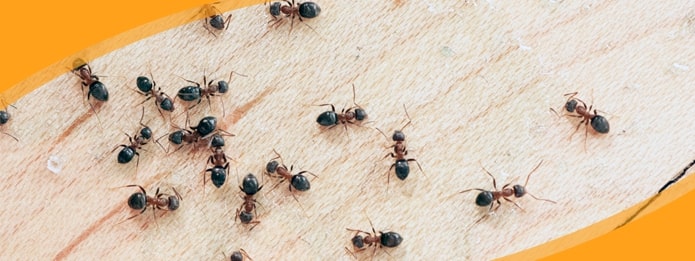How Are These Carpenter Ants Getting Inside the House?

There are few pests that are as destructive as carpenter ants. Similar to termites, carpenter ants chew away wood elements around your home. These pests can be even more sneaky and can compromise the foundation of your home with few outward indications. Learn to spot the signs of a carpenter ant colony, discover where they usually start their attack and find out how the Truly Nolen pest control Kitchener location can help.
Common Entry Points
Carpenter ants don’t eat wood. Unlike termites, they are simply digging out channels in the wood support structures of your home in order to build a nest. They aren’t looking for fresh, tasty wood but simply want the easiest route. Because of this, look for wood elements around your home that have one or more of these features:
- Excess moisture
- Fungal growth
- Rot
Wood with these issues is easier to burrow into, so inspect outdoor wooden furniture, wood in your crawl space and other exterior components. Because carpenter ants don’t eat wood, you may also see workers searching for food. Some ants may be in your house looking to raid your cupboards, but carpenter ants typically eat food outside your home.
First Signs of Carpenter Ants
These sneaky ants keep a tidy home, so it can be difficult to know whether you have an infestation in your house in Niagara. Here are some signs to look for when inspecting your foundation, outdoor furniture or basement:
- Small entry holes
- Frass, which is insect body parts, insulation and wood shavings
- Carpenter ants searching for food
These ants are usually red or black, but they can be a combination of colours or have a brownish look. Their body is segmented and oval, and they can be up to 5/8ths of an inch long or about 15.8 millimetres.
Make an effort to carefully inspect your home for entry points. These small holes in the framing or wood siding of the structure is a key sign that carpenter ants are setting up a colony. You may see frass at the entrance to some of these holes, but in general, carpenter ants are tidy and keep their entrances fairly clean.
Signs of an Established Colony
These minor signs may not seem like an issue, but they can quickly lead to an established carpenter ant colony in your house. Here are some signs to watch out for that typically mean you have an established colony:
- Large amounts of carpenter ants
- Many piles of frass
- Flying ants near your windows
- Stuck windows and doors and sloping floors
Because carpenter ants aren’t typically interested in the food in your home, seeing a large number of them around your property usually means that there are far more ants that you are not seeing. Swarmers flying inside or outside your windows means there is a colony nearby, usually in your home, that is mature enough to support males and females that will go out to create a new colony. This is bad news for your residence.
The final sign of a serious carpenter ant problem is stuck windows and doors or sloping floors. While windows and doors may bulge slightly from temperature and moisture changes, these issues can also be signs that carpenter ants have dramatically affected the structure of your home.
How To Remove Carpenter Ants in Niagara
Don’t wait until your home is severely damaged by carpenter ants. Truly Nolen Canada is your leading pest control team in Kitchener, so you can count on us to identify any carpenter ant problem. Schedule an inspection with us today to see how carpenter ants have gotten into your home and learn how to safely, effectively remove them and protect your property.